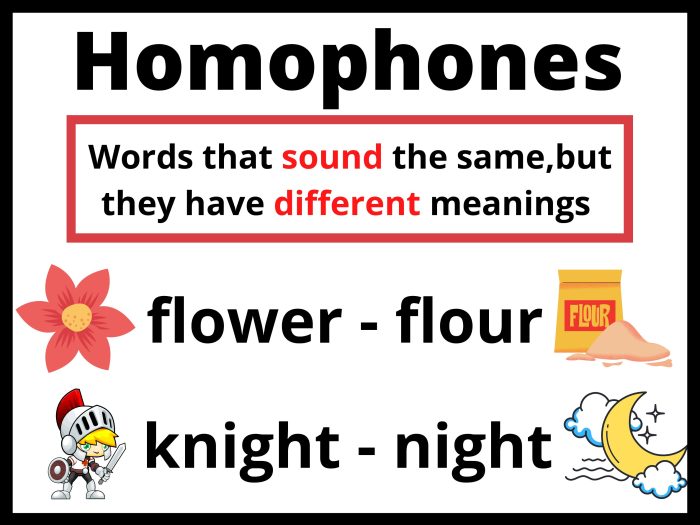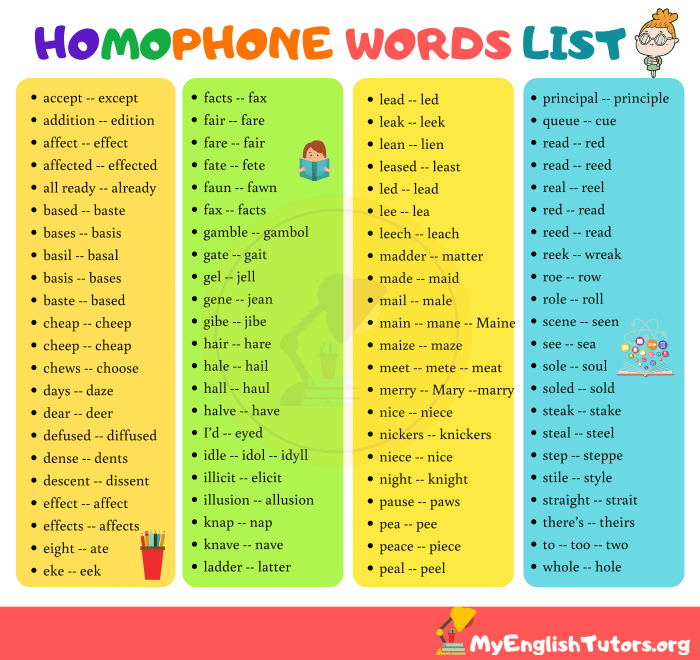Words and phrases that sound approximately alike, often referred to as homophones, homographs, and near-homophones, present intriguing linguistic phenomena that impact communication, literature, and cultural understanding. This comprehensive guide delves into the intricacies of these phonetic similarities, exploring their definitions, usage, and implications.
From the confusion caused by homophones to the subtle nuances of near-homophones, this discussion unravels the complexities of language and its intricate tapestry of sounds.
Phonetic Similarity

Phonetic similarity refers to the phenomenon where words or phrases share similar sounds, even though they may have different meanings or spellings. This similarity arises from the shared phonetic features, such as similar vowel or consonant sounds, within the words or phrases.
Examples of words and phrases that sound alike due to phonetic similarity include:
- cat and cot
- bat and bat
- write and right
- sea and see
Homophones
Homophones are words that have the same pronunciation but different meanings and spellings. They often cause confusion and ambiguity in communication, especially when used in writing or when spoken quickly.
| Homophone | Meaning 1 | Meaning 2 |
|---|---|---|
| here | in this place | at this place |
| their | belonging to them | belonging to him/her |
| to | direction | belonging to |
| two | number | too |
Homographs
Homographs are words that have the same spelling but different meanings and pronunciations. Unlike homophones, they do not sound alike. Context plays a crucial role in distinguishing between homographs.
- bow (weapon) vs. bow (knot)
- wind (air) vs. wind (turn)
- live (alive) vs. live (reside)
Homonyms

Homonyms encompass both homophones and homographs. They are words that have the same spelling and pronunciation, but may have different meanings or origins.
| Word | Homophone | Homograph |
|---|---|---|
| bank | Yes | No |
| bat | Yes | Yes |
| read | No | Yes |
| bow | No | Yes |
Near-Homophones

Near-homophones are words that sound almost alike but have different meanings and spellings. They can lead to mispronunciation or confusion, especially when spoken quickly or in noisy environments.
- brake vs. break
- flower vs. flour
- wood vs. would
Cultural and Regional Influences
Cultural and regional influences play a significant role in shaping words and phrases that sound alike. Dialects and accents can vary greatly, leading to different pronunciations of the same word or phrase.
- In some dialects, “cot” and “caught” may sound alike, while in others they are distinct.
- The pronunciation of “water” can vary significantly across regions, from “waw-ter” to “wah-ter”.
Historical Evolution
Language changes over time, and so do the sounds of words and phrases. Sound shifts, mergers, and splits can lead to the creation of words and phrases that sound similar.
- The Great Vowel Shift in English, which occurred between the 15th and 17th centuries, led to significant changes in the pronunciation of many words.
- The merger of the sounds /i/ and /e/ in many American dialects has resulted in words like “pin” and “pen” sounding alike.
Poetic and Literary Devices
Poets and writers often use words and phrases that sound alike for literary effect. These devices include:
- Alliteration:the repetition of the same consonant sound at the beginning of words.
- Assonance:the repetition of the same vowel sound in close proximity.
- Rhyme:the repetition of the same vowel and consonant sounds at the end of words.
These devices create rhythm, flow, and emphasis in literary works.
FAQ Overview: Words And Phrases That Sound Approximately Alike
What is the difference between a homophone and a homograph?
Homophones are words that sound the same but have different spellings and meanings, while homographs are words that have the same spelling but different meanings.
How can near-homophones lead to miscommunication?
Near-homophones can be easily mispronounced or confused, leading to misunderstandings in both spoken and written communication.
What role do cultural and regional influences play in shaping words that sound alike?
Cultural and regional variations in pronunciation can result in words that sound similar in one region but different in another, impacting communication and understanding.
